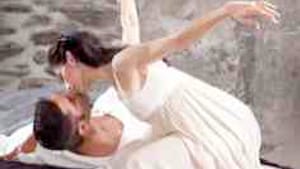Stay in the Loop
BSR publishes on a weekly schedule, with an email newsletter every Wednesday and Thursday morning. There’s no paywall, and subscribing is always free.
Who needs Shakespeare?
Pennsylvania Ballet's "Romeo and Juliet'

Whenever I hear a writer— even Otis Redding— utter the phrase "more than words can say," I assume he's lazy. Shakespeare, after all, scribbled 884,429 words over the course of 38 plays and more than 100 poems.
But after seeing the Pennsylvania Ballet's current production of John Cranko's Romeo and Juliet, I'm tempted to think we don't even need the Bard's eloquence to tell this love story. Cranko not only concentrates the plot while enlivening it; he also overcomes problems that for me, have always plagued Shakespeare's classic tale.
His ballet cuts to the chase by opening on a thrilling ensemble fight scene. Cranko needs no prologue ("Two houses, both alike in dignity") to convey clan-driven hostility. Instead his staging shows total enmity via two noblewomen spitting at one another and an aging Lord Capulet and Montague parrying with broadswords.
The choreography concentrates the love affair by eliminating the more pedantic characters (like the apothecary) and cutting most of the Friar's cloying lines. In the balcony scenes, Cranko similarly drops the nurse's annoying intrusions. Sure, pesky mothering types occur in every young girl's life. But why include them in art, especially when the whole audience waits expectantly for that first kiss?
Cranko's version expands the tragedy to include all those who suffer. In Shakespeare's telling, the real tragedy of Tybalt's death lay not in a young man's life cut short, but in Romeo's banishment after the fact. But Cranko closes his second act not on Romeo's exile but on a wailing, dress-rending Lady Capulet (Amy Aldridge). The curtain drops as she's carried out atop Tybalt's body, rendering a more chilling or powerful moment than any scene in the play.
Mercutio as Steve Martin
Cranko proves most inventive in the comedy scenes. Shakespeare gives Mercutio longwinded— though riotous— speeches ("Queen Mab") to dazzle with comedic dexterity. Instead of jokes, Cranko's Mercutio (Jonathan Stiles) flaps his arms and crashes the Capulet ball by teasing the guests with shoulder taps. Like Steve Martin in The Jerk, he evokes laughs with sloppy antics and mannerisms. And where Shakespeare lightens Mercutio's death with quips ("Look for me tomorrow, and you shall find me a grave man"), here Mercutio plays a game of "got your nose" while languishing in a wench's arms.
Cranko's Juliet is no mere pawn of her parents or appendage of Romeo's affections. When presented with a new dress for her debutante ball, her joy cracks in the discovery of busty new proportions. And Cranko's decision to flesh out Paris's character also expands Juliet's; rather than simply succumbing to Romeo's seduction, Juliet now makes an active choice.
Juliet backpedals on pointe away from Paris in the same manner that she moves toward Romeo, and while Paris lifts her into a half-turn, with Romeo she soars across the stage. Later, when forced to consent to Paris's proposal (after Romeo's banishment), she shores up her courage to take the friar's poison by gliding toward Paris with the steps that led her into Romeo's arms. It's a heartbreaking expression of the loyalty that leads to tragedy.
Throughout, Arantxa Ochoa executes every motion— not only with her lovely, flowing limbs— but also with expressions that display a real mixture of pathos and affection. Under John Hoey's lighting, her porcelain skin glows with an innocence that truly teaches the torches to burn bright.
Friends and lovers
As for Romeo? With words, it's easy to dismiss his sudden infatuation with Juliet after we hear his similar exhortations of love to Rosaline. Cranko plays a similar trick— Romeo rushes in to meet Juliet with the same cape-draping, running flourish that he first shows for Rosaline—but his choreography achieves a much different effect.
As a production, the Pennsylvania Ballet puts more opulence onstage than I've seen anywhere this season. The costumes dazzle, from the ribboned armor of the Duke's guards and the Lady's draping gowns and the husbands' fur-lined coats, to Juliet's simple yet shimmering cream and gold fleur-de-lis embroidered shift.
The sets, painted in shadow-filled colors, enhance the fairy tale feel. Beatrice Affron's conducting captivates the audience through the orchestra's magnificent playing of Prokofiev's score.
Unlike repertory companies in New York or elsewhere, the Pennsylvania Ballet often takes long stretches between its productions of full-length story-driven dance. But when a ballet troupe can dispense with Shakespeare to tell the greatest love tale ever written, it's worth the wait.
But after seeing the Pennsylvania Ballet's current production of John Cranko's Romeo and Juliet, I'm tempted to think we don't even need the Bard's eloquence to tell this love story. Cranko not only concentrates the plot while enlivening it; he also overcomes problems that for me, have always plagued Shakespeare's classic tale.
His ballet cuts to the chase by opening on a thrilling ensemble fight scene. Cranko needs no prologue ("Two houses, both alike in dignity") to convey clan-driven hostility. Instead his staging shows total enmity via two noblewomen spitting at one another and an aging Lord Capulet and Montague parrying with broadswords.
The choreography concentrates the love affair by eliminating the more pedantic characters (like the apothecary) and cutting most of the Friar's cloying lines. In the balcony scenes, Cranko similarly drops the nurse's annoying intrusions. Sure, pesky mothering types occur in every young girl's life. But why include them in art, especially when the whole audience waits expectantly for that first kiss?
Cranko's version expands the tragedy to include all those who suffer. In Shakespeare's telling, the real tragedy of Tybalt's death lay not in a young man's life cut short, but in Romeo's banishment after the fact. But Cranko closes his second act not on Romeo's exile but on a wailing, dress-rending Lady Capulet (Amy Aldridge). The curtain drops as she's carried out atop Tybalt's body, rendering a more chilling or powerful moment than any scene in the play.
Mercutio as Steve Martin
Cranko proves most inventive in the comedy scenes. Shakespeare gives Mercutio longwinded— though riotous— speeches ("Queen Mab") to dazzle with comedic dexterity. Instead of jokes, Cranko's Mercutio (Jonathan Stiles) flaps his arms and crashes the Capulet ball by teasing the guests with shoulder taps. Like Steve Martin in The Jerk, he evokes laughs with sloppy antics and mannerisms. And where Shakespeare lightens Mercutio's death with quips ("Look for me tomorrow, and you shall find me a grave man"), here Mercutio plays a game of "got your nose" while languishing in a wench's arms.
Cranko's Juliet is no mere pawn of her parents or appendage of Romeo's affections. When presented with a new dress for her debutante ball, her joy cracks in the discovery of busty new proportions. And Cranko's decision to flesh out Paris's character also expands Juliet's; rather than simply succumbing to Romeo's seduction, Juliet now makes an active choice.
Juliet backpedals on pointe away from Paris in the same manner that she moves toward Romeo, and while Paris lifts her into a half-turn, with Romeo she soars across the stage. Later, when forced to consent to Paris's proposal (after Romeo's banishment), she shores up her courage to take the friar's poison by gliding toward Paris with the steps that led her into Romeo's arms. It's a heartbreaking expression of the loyalty that leads to tragedy.
Throughout, Arantxa Ochoa executes every motion— not only with her lovely, flowing limbs— but also with expressions that display a real mixture of pathos and affection. Under John Hoey's lighting, her porcelain skin glows with an innocence that truly teaches the torches to burn bright.
Friends and lovers
As for Romeo? With words, it's easy to dismiss his sudden infatuation with Juliet after we hear his similar exhortations of love to Rosaline. Cranko plays a similar trick— Romeo rushes in to meet Juliet with the same cape-draping, running flourish that he first shows for Rosaline—but his choreography achieves a much different effect.
As a production, the Pennsylvania Ballet puts more opulence onstage than I've seen anywhere this season. The costumes dazzle, from the ribboned armor of the Duke's guards and the Lady's draping gowns and the husbands' fur-lined coats, to Juliet's simple yet shimmering cream and gold fleur-de-lis embroidered shift.
The sets, painted in shadow-filled colors, enhance the fairy tale feel. Beatrice Affron's conducting captivates the audience through the orchestra's magnificent playing of Prokofiev's score.
Unlike repertory companies in New York or elsewhere, the Pennsylvania Ballet often takes long stretches between its productions of full-length story-driven dance. But when a ballet troupe can dispense with Shakespeare to tell the greatest love tale ever written, it's worth the wait.
What, When, Where
Pennsylvania Ballet: Romeo and Juliet. Music by Sergei Prokofiev; choreography by John Cranko. Through June 12, 2010 at the Academy of Music, Broad and Locust Sts. (215) 551-7000 or www.paballet.org.
Sign up for our newsletter
All of the week's new articles, all in one place. Sign up for the free weekly BSR newsletters, and don't miss a conversation.

 Jim Rutter
Jim Rutter